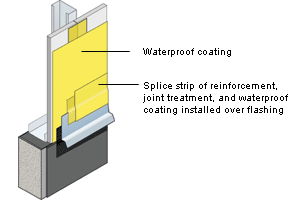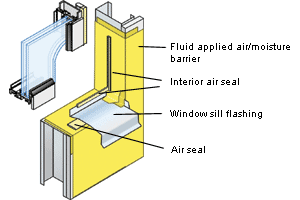Fluid Applied Air/Moisture Barriers for Moisture Control and Mold Prevention in Wall Construction
Mechanical Ventilation
A properly functioning air barrier system will limit the influence of air infiltration and exfiltration on the heating and cooling loads of the interior environment. This can increase the efficiency of the HVAC system, which translates into energy cost savings. However, the mechanical ventilation system must still perform its basic functions of:
- Ventilation and exhaust
- Proper distribution of makeup air to interior spaces
- Dehumidification of air
- Filtration of outdoor air
Wind effects, stack effects, fan effects and space configuration and partitions influence how the mechanical ventilation system must be designed to perform adequately. ASHRAE handbooks provide guidance on mechanical ventilation, and design and control of interior relative humidity conditions to control microbial growth, to minimize condensation potential, and to provide occupant comfort, in relation to air leakage.
|
||||||||||||||
Construction Details and Sequencing
"As much as 90 percent of all water intrusion problems occur within one percent of the total building exterior surface area. The one percent of the structure's façade contains the terminations and transition detailing that all too frequently lead to envelope failures."3
Construction detailing is a critical component for the success of any wall assembly. The designer must create details that effectively:
Control rain water penetration that may occur via:
- Gravity flow-water that flows down and to the interior if surfaces are sloped towards the interior, for example, an improperly sloped brick ledge
- Kinetic energy-rainwater, for example, being blown directly into large openings
- Capillary action-the tendency of water to travel through narrow openings or cracks in materials toward dryer surfaces, for example, a crack in a mortar joint
- Pressure differentials-the effects of wind pressure, stack effect or mechanical ventilation that create pressure differences across the building envelope, and drive water through cracks or openings
Control condensation that may occur via:
- air leakage
- diffusion
|
||||||||||||||
The contractor must in turn coordinate and sequence work so that details are properly constructed. Given that today's buildings are generally "tighter" than they were 50 years ago, the importance of eliminating water intrusion into wall assemblies increases substantially, since water in walls may not readily dry. Some details are fundamental, such as the proper sloping of sills and ledges to the exterior, use of drip edges at soffit returns, capillary breaks in construction joints, or lapping of the air/moisture barrier over flashing at the base of a wall (Figure 4) to direct water to the exterior. Other details are more complex, such as maintaining the continuity of the air barrier at a window penetration (Figure 5) and integrating the air/moisture barrier with sill flashing. Whatever the detail, whether straightforward or complex in nature, the development and execution of details is vital to the long term success of the wall assembly, regardless of how well the air/moisture barrier system performs. An important advantage of a fluid applied air/moisture barrier in the wall assembly is that it can mitigate or eliminate one of the major forces that cause water infiltration into walls: pressure difference. The fluid applied air/moisture barrier, in combination with venting and compartmenting, can effectively enable the pressure behind the cladding material to equalize with the pressure outside, and prevent rain water penetration caused by pressure differentials (pressure equalized rainscreen).
|












